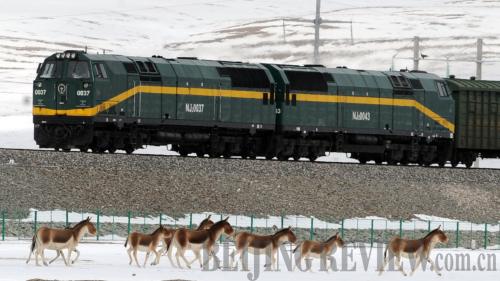|
 |
|
PEACEFUL COEXISTENCE: Wild donkeys wander along the Qinghai-Tibet Railway on November 11, 2009, despite a passing train (HOU DEQIANG) |
In summer the vast wildness of Qinghai-Tibet Plateau in west China teems with life. And while the plateau is home to a stunning range of wildlife, the annual migration of Tibetan antelopes, an elegant endangered animal living on the plateau, is particularly spectacular.
Every May and June, female Tibetan antelopes travel up to 300 km to reach their breeding grounds. Then, just a month after giving birth, they begin the journey to their winter pastures. Today, even though a railway and a highway cut across their migration route, the antelopes continue their annual migration.
"The Qinghai-Tibet Railway, which has been in operation for five years, has not changed the foraging, migration and breeding behaviors of Tibetan antelopes," said Miao Xiaohua, Vice President of the Qinghai-Tibet Railway Co.
On the afternoon of July 27, nearly 40 Tibetan antelopes were observed galloping across the Qinghai-Tibet Highway and Qinghai-Tibet Railway.
When the herd approached the railway, they paused. Two adult antelopes and a fawn scurried through the passage under the railway's Wubei Bridge. Only after seeing these front-runners were safe, did the remainder of the herd follow.
Experts say about 90 percent of migrating antelopes go though the passage under Wubei Bridge, one of the 33 wildlife passages along the 1,956-km-long Qinghai-Tibet Railway.
Life passages
The pristine natural ecological system in the Qinghai-Tibet Plateau is unique and fragile. On the freezing heights of the "Roof of the World," the average annual temperature is 4-6 degrees Celsius. The plateau is the source of several large rivers in China including the Yellow River, the Yangtze River and the Lancang River. It is also the natural habitat of rare animals such as Tibetan antelopes, Tibetan wild donkeys and snow leopards.
Tibetan antelopes are listed as endangered animal by the World Conservation Union. In the last century they were hunted for their warm, soft and expensive wool, which is woven into the luxury fabric shahtoosh.
In the 1980s alone, rampant poaching reduced the antelope population from 200,000 to 20,000, said the Xinhua News Agency. And numbers only recovered after the Chinese Government set up nature reserves in the Qinghai-Tibet Plateau around the turn of the 20th century.
The Qinghai-Tibet Railway cuts through the Sanjiangyuan, Qiangtang and Hoh Xil nature reserves, the Tibetan antelopes' major natural habitat.
Even before the ground was broken for the railway, worries about its environmental impact abounded.
"We put the environment first while constructing and running the railway," Miao said.
To minimize the disruption to wildlife, 33 migration passages have been built along the railway.
That was the first time that such "green" passages were incorporated into a major Chinese engineering project, Miao said.
Twenty-five of the passages are in Qinghai Province and eight are in Tibet Autonomous Region, with a total length of 58.4 km, said Yang Qisen, a research fellow with the Institute of Zoology of the Chinese Academy of Sciences. Yang designed the passages following lengthy observation of animal behavior on the plateau.
In sensitive spots, the railway goes through tunnels or over bridges to avoid severing animals' migration routes; in other places, gently-sloped overpasses have been built for animals to cross the track. At the section of the railway that travels through the area most frequently passed by migrating antelopes, many bridges were built, including 143 flyovers, each more than 100 meters long.
"In addition to building 'green' passages, railway employees are required to postpone or suspend ongoing projects that interfere with antelopes' migration," Miao said.
"These efforts have paid off. In recent years, an increasing number of Tibetan antelopes have been observed migrating," said Xiao Penghu, deputy chief of the Hoh Xil Nature Reserve.
The number of antelopes living in the Hoh Xil Nature Reserve and its vicinity has also increased from nearly 50,000 in 2006, when the railway started operation, to about 60,000 now, Xiao said.
| 